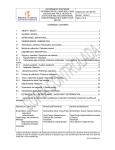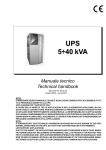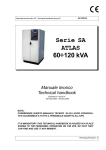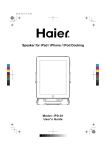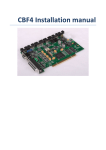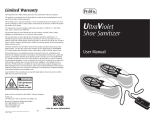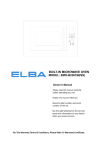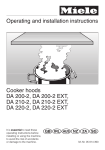Download Miele DA210-3 Operating instructions
Transcript
Operating instructions for Cooker Hoods DA 200, DA 200 EXT, DA 210, DA 210 EXT, DA 220, DA 220 EXT It is essential to read these operating instructions before installing or using the machine, to avoid the risk of accident or damage to the machine. Q@ä M.-Nr. 04 805 250 Contents Contents Caring for the environment . . . . . . . . . . . . . . . . . . . . . . . . . . . . . . . . . . . . . . . . . . 3 Warning and Safety instructions . . . . . . . . . . . . . . . . . . . . . . . . . . . . . . . . . . . . . 4 Descripton of the functions. . . . . . . . . . . . . . . . . . . . . . . . . . . . . . . . . . . . . . . . . . 8 Guide to the appliance DA 200, DA 200 EXT . . . . . . . . . . . . . . . . . . . . . . . . . . . . . . . . . . . . . . . . . . . . . . . . 9 DA 210, DA 210 EXT . . . . . . . . . . . . . . . . . . . . . . . . . . . . . . . . . . . . . . . . . . . . . . . 10 DA 220, DA 220 EXT . . . . . . . . . . . . . . . . . . . . . . . . . . . . . . . . . . . . . . . . . . . . . . . 11 Operation Switching on. . . . . . . . . . . . . . . . . . . . . . . . . . . . . . . . . . . . . . . . . . . . . . . . . . . . . . Switching the lighting on and off . . . . . . . . . . . . . . . . . . . . . . . . . . . . . . . . . . . . . . Selecting the power level . . . . . . . . . . . . . . . . . . . . . . . . . . . . . . . . . . . . . . . . . . . . Run-on option. . . . . . . . . . . . . . . . . . . . . . . . . . . . . . . . . . . . . . . . . . . . . . . . . . . . . Switching off. . . . . . . . . . . . . . . . . . . . . . . . . . . . . . . . . . . . . . . . . . . . . . . . . . . . . . Filter operating hours counter . . . . . . . . . . . . . . . . . . . . . . . . . . . . . . . . . . . . . . . . Reading the filter operating hours counter . . . . . . . . . . . . . . . . . . . . . . . . . . . . Altering the filter operating hours counter . . . . . . . . . . . . . . . . . . . . . . . . . . . . 12 12 12 13 13 14 14 14 Cleaning and Care Housing . . . . . . . . . . . . . . . . . . . . . . . . . . . . . . . . . . . . . . . . . . . . . . . . . . . . . . . . . 15 Grease filters . . . . . . . . . . . . . . . . . . . . . . . . . . . . . . . . . . . . . . . . . . . . . . . . . . . . . 15 Changing a light bulb. . . . . . . . . . . . . . . . . . . . . . . . . . . . . . . . . . . . . . . . . . . . . . . 16 After sales service . . . . . . . . . . . . . . . . . . . . . . . . . . . . . . . . . . . . . . . . . . . . . . . . 17 Electrical connection and Technical data . . . . . . . . . . . . . . . . . . . . . . . . . . . . . 18 Appliance dimensions . . . . . . . . . . . . . . . . . . . . . . . . . . . . . . . . . . . . . . . . . . . . . 19 Installation . . . . . . . . . . . . . . . . . . . . . . . . . . . . . . . . . . . . . . . . . . . . . . . . . . . . . . 20 Connection for extraction . . . . . . . . . . . . . . . . . . . . . . . . . . . . . . . . . . . . . . . . . . 24 Connection to an external fan. . . . . . . . . . . . . . . . . . . . . . . . . . . . . . . . . . . . . . . 26 Caring for the environment Caring for the environment Disposal of packing material Disposal of your old machine / appliance The transport and protective packing has been selected from materials which are environmentally friendly for disposal and can normally be recycled. Old machines / appliances contain materials which can be reclaimed or recycled. Please contact your dealer, your waste collection centre or scrap merchant about potential recycling schemes. Rather than just throwing these materials away, please ensure they are offered for recycling. Ensure that the machine / appliance presents no danger to children while being stored for disposal. See the appropriate section in the Warning and Safety instructions. 3 Warning and Safety instructions Warning and Safety instructions This appliance meets statutory safety requirements. Inappropriate use could however lead to risk of accidents to the user and damage to the appliance. Read the operating instructions before using this machine for the first time. They contain important information about the safety, use and maintenance of the machine. This will avoid the risk of accidents and damage to the machine. Keep these operating instructions in a safe place and ensure that new users are familiar with the content. Pass them on to any future owner of the machine. Appropriate use of the cooker hood The appliance is intended for domestic use only. The manufacturer cannot be held responsible for any damage caused by improper use or by non-observance of these instructions. Technical safety Before connecting the cooker hood to the mains supply make sure that the voltage and frequency details given on the data plate correspond with the on-site electricity supply. If in doubt consult a qualified electrician. The electrical safety of this appliance can only be guaranteed when continuity is complete between the appliance and an effective earthing system which complies with local and national regulations. It is most important that this basic safety requirement is tested by a qualified electrician. The manufacturer cannot be held responsible for the consequences of an inadequate earthing system. (e.g. electric shock). Installation work and repairs may only be carried out by suitably qualified and competent persons to ensure safety. Repairs and other work by unqualified persons could be dangerous. 4 Warning and Safety instructions The appliance is only completely isolated from the electricity supply when: – it is switched off at the wall socket and the plug removed, – the mains fuse is withdrawn; – or the screw-out fuse is removed, (in countries where this is applicable). Ensure current is not restored to the appliance while maintenance or repair work is being carried out. Do not connect the appliance to the mains electricity supply by an extension lead. Extension leads do not guarantee the required safety of the appliance.(e.g. danger of overheating) Use of the appliance Never use an open flame beneath the cooker hood - to avoid the danger of fire do not flambé or grill dishes. When switched on the cooker hood could draw flames into the filter. Fat particles drawn into the cooker hood present a fire hazard. When using the cooker hood over a gas hob ensure that any burners in use are always covered by a pan. Otherwise flames could be drawn up by the suction of the cooker hood, parts of which could then be damaged. Always switch the cooker hood on when a cooking zone is in use, otherwise condensation may collect in the hood, which could cause corrosion. When cooking with oil or fat, chip pans and deep fat fryers etc, do not leave the pans unattended. Overheated oil and fat can ignite and could set the cooker hood on fire. Do not use the cooker hood without the grease filter in place. This way you will avoid the risk of grease and dirt getting into the appliance and hindering its smooth operation. 5 Warning and Safety instructions The filters should be regularly cleaned, or changed, as appropriate. Saturated filters are a fire hazard. Under no circumstances use a steam cleaner to clean this appliance. Pressurised steam could give rise to a short circuit, or cause permanent damage to the surface and to components, for which the manufacturer of the cooker hood cannot accept any responsibility. In countries which may be subject to infestation by cockroaches or other vermin, pay particular attention to keeping the appliance and its surroundings in a clean condition at all times. Any damage which might be caused by cockroaches or other vermin will not be covered by the appliance guarantee. Installation The distance between the top of the hob and the bottom of the cooker hood (when the vapour guide is completely retracted) must measure at least: – 55 cm above electric hobs – 65 cm above gas hobs. (Australia: 60 cm for electric and gas hobs) Only for U.K.: The distance of 65 cm between the cooker hood and a gas hob is a minimum, which is only permissible if the nominal heat ratings giveb in the table below are not exceeded: Gas cooker maximum nominal rating one burner all burners 2.7 kW 7.5 kW oven 3.5 kW Gas hob one burner maximum nominal rating 3.5 kW all burners 10.3 kW Gas hob with ceramic cover plate The data given for maximum nominal (heat) ratings do not aply to a gas hob with a ceramic cover plate. In this case it is essential to refer to the hob manufacturer’s data. Safety regulations prohibit the fitting of a cooker hood over solid fuel stoves. All ducting, pipework and fittings must be of non-flammable material. These can be obtained from the Miele Spare Parts department or from builders’ merchants. The appliance must not be connected to a chimney or vent flue which is in use. Neither should it be connected to ducting which ventilates rooms with fireplaces. If exhaust air is to be extracted into a chimney or ventilation duct no longer used for other purposes, take professional advice. 6 Warning and Safety instructions When using the cooker hood at the same time as another heating appliance which depends on the air in the room, (e.g. gas, oil or coal fired heaters, continuous flow or other water heaters, gas cooker, gas hob or gas oven) special care must be taken, as the action of the cooker hood extracts air from the room, which these types of heater need for combustion. In order to ensure safe operation, and to prevent the gases given off by the heating appliances from being drawn back into the room when the extractor and the heater are in operation simultaneously, an underpressure in the room of 0.04 mbar (4 pa) is the maximum permissible. Ventilation can be maintained by air inlets which cannot be blocked, in windows, doors and outside wall vents, or by other techical measures, such as ensuring that the extractor can only be switched on when the heating appliance is switched off or vice-versa. only for appliances with external fans For appliances with an external fan motor fitted (EXT models) the connection of the two units must be made using the connection cable and the plug connectors. Make sure the correct combination of the two appliances has been selected. Disposal of an old machine / appliance Before discarding an old machine or appliance render it useless. Ensure that disconnection from the mains supply is carried out by a competent person and that the cable is also removed from the appliance to prevent misuse. The manufacturer cannot be held responsible for any damage caused by non-observance of these instructions. N.B.: The overall ventilation condition of the dwelling must be taken into account. If in any doubt, the advice of a competent builder or, for gas, a “Corgi” installer must be sought. 7 Descripton of the functions Descripton of the functions The cooker hood works with . . . Air extraction: The air is drawn in and cleaned by the grease filters and directed outside. The cooker hood is fitted with a non-return flap. This flap is closed when the cooker hood is switched off. No exchange of room air and outside air can take place. When the cooker hood is switched on the non-return flap opens for the cooking smells to be blown directly outside. 8 . . . an external fan The ...EXT models of cooker hoods are designed to be connected with an external fan. The external fan is connected to the cooker hood by means of a control cable and is operated by the control panel on the cooker hood. Guide to the appliance Guide to the appliance DA 200, DA 200 EXT b Touch control for hob lighting c On/Off touch control d Touch control - power level e Touch control for the run-on option f Touch control for the grease filter(s) g Cover frame h Tower i Vapour guide j Main switch 9 Guide to the appliance DA 210, DA 210 EXT b Touch control for hob lighting c On/Off touch control d Touch control - power level e Touch control for the run-on option f Touch control for the grease filter(s) g Cover frame h Tower i Vapour guide j Main switch 10 Guide to the appliance DA 220, DA 220 EXT b Touch control for hob lighting c On/Off touch control d Touch control - power level e Touch control for the run-on option f Touch control for the grease filter(s) g Cover frame h Tower i Vapour guide j Main switch 11 Operation Operation To select the functions, press the touch controls gently with your finger. Selecting the power level The relevant indicator lamp glows. Depending on how much the air needs to be filtered, there are four power levels available. For normal cooking a low to medium level is usually enough. For frying or cooking food with a strong aroma the highest level is recommended. Switching the lighting on and off The cooker hood is set to run on a medium level when it is switched on using the On/Off touch control. Switching on Set the main switch to "I". Press the On/Off touch control. The hob lighting can be switched on and off independently of the fan. Press the touch control for the hob lighting. When it is switched on the lighting indicator lamp glows. However, when the main switch is used or after an interruption to the power supply, the cooker hood will operate on the power level last selected. Use the _ touch control to select the power level required. $ control = lower setting > control = higher setting The indicator lamps show which power level has been chosen. 12 Operation Run-on option If the air still needs to be cleared after cooking, the cooker hood can be set to continue running. It will then switch off the fan motor automatically after a further 5 or 15 minutes. Press the run-on option touch control. Press once = 5 minutes run-on time Press twice = 15 minutes run-on time The relevant indicator lamp glows to confirm the time selected. To switch the run-on option off, press the run-on option touch control again. Switching off Use the On/Off touch control to switch the fan off. Only use the main switch if the cooker hood is not going to be used for a longer period of time (e.g. overnight, holidays). Safety switch-off feature Should the cooker hood have been left switched on, the fan will switch off automatically after 10 hours. The lighting remains on. Pressing the On/Off touch control will switch the fan back on again. 13 Operation Filter operating hours counter An indictor lamp shows when the grease filter needs to be changed. The operating hours counter is set at the factory for a certain number of hours, but these can be changed. At the end of the set period the grease filter indicator lamp glows. The grease filter(s) must then be cleaned. The filter operating hours counter must then be re-set for the same period as before. Press the grease filter touch control for about 4 seconds. The indicator lamp will go out. Reading the filter operating hours counter Before reaching the end of the period set, you can check the percentage of the time set which has already been used up. Use the On/Off touch control to switch the fan on. Press the grease filter touch control. Altering the filter operating hours counter You can match the maximum time for the filter operating hours counter to suit the type of cooking you do. You can choose from 20, 30, 40 or 50 hours. Select a short time if you roast and fry a lot. Use the the On/Off touch control to switch the fan off. Press the run-on option touch control and the grease filter touch control at the same time. The indicator lamps for the grease filter touch control and the _ touch control will flash. Use the _ touch control to select the required time. The _ touch control indicator lamps show the time which has been set: 1st lamp from the left = 20 hours 2nd lamp from the left = 30 hours 3rd lamp from the left = 40 hours 4th lamp from the left = 50 hours One or several of the grease filter indicator lamps will glow. Confirm the procedure by pressing the grease filter touch control. The number of flashing lamps show the percentage of the operating time set which has already been used up.: If the procedure is not confirmed within 4 minutes of programming the steps, the cooker hood will automatically revert to the "old" data. 1 lamp = less than 25 % 2 lamps = less than 50 % 3 lamps = less than 75 % 4 lamps = less than 100 % The operating hours completed remain in memory, even when the machine is switched off or there is a power cut. 14 Cleaning and Care Cleaning and Care Before any cleaning or maintenance work the cooker hood must be disconnected from the mains supply by – withdrawing the fuse from the fused spur connection unit (if accessible), or – withdrawing the mains fuse, or – removing the screw-out fuse (in countries where this is applicable). Housing The cooker hood housing may be cleaned using hot water to which a little mild detergent has been added. Dry with a soft cloth. An over-greasy filter is a fire hazard. To remove a grease filter press the hand hold catch towards the middle of the filter. Remove the filter. Clean the filters Never use a cleaner which scours or contains chlorine, acids or soda. These would damage the surface of the cooker hood. A mild, non-abrasive proprietary stainless steel cleaner is suitable. Grease filters Re-usable metal grease filters are fitted which remove solid particles (oil, dust, etc.) from the kitchen vapours, preventing soiling of the cooker hood. The grease filters should be cleaned regularly, but always clean immediately the grease filter touch control lamp comes on. – by hand: with a scrubbing brush in hot water with detergent. – in a dishwasher: place the filters with the short side upright in the lower basket, ensuring the spray arm is not obstructed. After cleaning leave the filters to dry for a while on an absorbent surface before putting them back in place. When removing the filters for cleaning also clean off any residues of oil or fat from the now accessible housing to prevent the risk of these catching fire. When putting the grease filters back ensure that the handhold catches face towards the hob. Should the grease filters be put back upside down, insert a small screwdriver into the slits to disengage them. Do not let them drop on to the hob below. 15 Cleaning and Care Changing a light bulb Disconnect the cooker hood from the mains supply by – withdrawing the fuse from the fused spur connection unit (if accessible), or – withdrawing the mains fuse, or – removing the screw-out fuse, (in countries where this is applicable). When in use the halogen bulbs become very hot. Do not touch immediately as it remains hot for some time after being switched off. Do not touch the bulb surface directly when changing the bulb as this will damage it (fat particles adhere to the surface). Please follow the manufacturer’s instructions. To change the halogen bulb first remove the outer ring b. Then detach the circlip c taking care that the glass d does not fall out. The halogen bulb e is fitted to a push-in connection socket. To replace pull out the old bulb and fit a new one. Replace the glass d and press the circlip c carefully into the holder. Never use the lighting without the lamp cover as it has a filter designed to cut out hamful rays. Now replace the outer ring b. 16 After sales service After sales service In the event of any faults which you cannot easily remedy, please contact: – Your Miele Dealer or – Your nearest Miele Service Dept, (see address on the back page). When contacting the Service Department, please quote the Model and Serial number of your machine / appliance, both of which are given on the data plate which is visible on removing the grease filter(s). 17 Electrical connection and Technical data Electrical connection and Technical data Electrical connection General notes All electrical work should only be undertaken by a suitably competent person in strict accordance with national and local safety regulations. For extra safety it is advisable to install a residual current device (RCD) with a trip current of 30 mA. Connection should be made by a double pole fused spur connection unit (only for GB). WARNING: THIS APPLIANCE MUST BE EARTHED The data plate gives the necessary data for connection. This is visible when the grease filter has been taken out. Check that these data correspond with the voltage and frequency of the on-site electricity supply. Technical data Rated load – DA 200, DA 210, DA 220 . . . . . 340 W – DA 200 EXT, DA 210 EXT, DA 220 EXT . . . . . . . . . . max. 410 W Lighting . . . . . . . . . . . . . . . . . . 4 x 20 W Voltage (U.K., AUS). . . . . . . . . . . 240 V Voltage (NZ) . . . . . . . . . . . . . . . . 230 V Frequency . . . . . . . . . . . . . . . . ~ 50 Hz Fuse rating (GB) . . . . . . . . . . . . . . 13 A AUS, NZ: Plug rating . . . . . . . . . . . . . . . . . . . 10 A Test marks . . . . . . . . . . Electrical safety, . . . . . . . . . . . . . C-Tick Mark Electrically suppressed according to . . . . . . . . . . AS/NZS 1044 Fan power – Extraction system ø 150 mm: Extraction power according to DIN 44971 Air extraction . . . . . . . . . . . . . . 785 m3/h – External fan: Extraction power (unimpeded flow) depending on the type of fan connected. 18 Appliance dimensions Appliance dimensions DA 200, DA 200 EXT DA 220, DA 220 EXT DA 210, DA 210 EXT 19 Installation Installation Safety regulations prohibit the fitting of this cooker hood over a solid fuel stove. The minimum safe distance between the top of the hob and the bottom of the cooker hood should be at least: – 55 cm above electric hobs, – 65 cm above gas hobs. (Australia: 60 cm for electric and gas hobs) A distance of 65 cm above electric hobs may be preferable to give more working space. Installation First make a hole (ø 190 mm) in the ceiling for the exhaust duct at the desired position. The pipe flange has a diameter of 150 mm. Mark a line on the ceiling centrally above the hob. 20 Installation Ceiling plate: DA 200 / DA 200 EXT Ceiling plate: DA 220 / DA 220 EXT Address the ceiling pate and position it exactly. The orange coloured arrow on the ceiling plate must face to the front of the cooker hood. Mark the position of the four holes to be drilled and the gap for the mains cable. Ceiling plate: DA 210 Select the cut-out providing the shortest route for the mains c connection cable to the cooker hood chimney connector. If the cooker hood is to be connected to an external fan motor, also mark the position of the gap for this connection cable. Lay a mains cable and an exhaust connection Ø 150 mm in the ceiling space. Ceiling plate: DA 210 EXT If the cooker hood is to be connected to an external fan motor, create the gap for the connection cable to the fan motor. Ensure that the diameter is sufficient to be able to feed through the 6-pole connector. 21 Installation In further description only one ceiling plate is shown. Drill 10 mm Ø holes in the ceiling, and insert S10 plugs into the holes. Prepare the ceiling plate for fitting. Push up the smooth angle of the spring clips e through the slots from below and tilt 90° so that the angle points towards the middle. Insert the four countersunk screws f (M 6 x 20) into the recessed holes from above. 22 Use the hose clip to secure the exhaust hose to the ceiling plate. Pull the mains connection cable through the ceiling plate. Screw the ceiling plate to the ceiling with the 8 x 60 mm screws and washers. With the EXT version the connection cable to the external fan must now be pulled through the appropriate gap. Use the cable extension provided if the position of the external fan makes it necessary. Make the connection between the cooker hood and the external fan with the 6pole connector. Installation Assemble the tower. Place the flange plate of the tower onto the ceiling plate in such a way that the spring clips click into the slots securely. Screw the flange plate firmly to the ceiling plate with the M6 nuts, the toothed lock washers and the flat washers. Shorten the cable for electrical connection as much as possible and secure inside the cooker hood chimney with the cable clips. Ensure all safety regulations are complied with. Finally, push the cover frame upwards until the spring fixing clips click in securely and the frame lies tightly against the ceiling. When doing this ensure that the toothed lock washers are arranged between the nuts (size M6) and the underlying washers to guarantee electrical safety. 23 Connection for extraction Connection for extraction Danger of toxic fumes. Please heed the "Warning and Safety instructions" to avoid the danger of toxic fumes. The cooker hood should be installed according to local building regulations. Seek approval from the building inspector where necessary. – When ducting is horizontal it must be laid to slope away at 1 cm per metre, to ensure no condensate drains into the appliance. – If the exhaust air is to be ducted into the open air the installation of a telescopic wall vent is recommended. Air extraction – The extraction ducting should be as short and straight as possible. – To ensure efficient air extraction the diameter of the exhaust ducting should not be less than 150 mm. The use of flat ducting also reduces the air extraction efficiency. The use of extraction ducting with a diameter of less than 150 mm and of flat ducting increases the noise level of the cooker hood. – Only use wide radius bends. Tight bends reduce the air throughput of the cooker hood. – Only use smooth or flexible pipes made from non-flammable materials for extraction connection. 24 – If the exhaust air is to be ducted into a vent flue the ducting must be directed in the flow direction of the flue. Connection for extraction Connection Only use narrower diameter pipework where it is unavoidable, for example where existing pipework has to be used. The narrower the diamater the lower the performance and the noiser the operation. Important If the exhaust ducting is to run through rooms, ceiling space etc., where there may be great variations in temperature between the different areas, the problem of sweating or condensation will need to be addressed. only for models DA 200, DA 210, DA 220: In addition to insulating the exhaust ducting we recommend that a suitable condensate trap is also installed to collect and evaporate any condensate which may occur. Condensate traps are available from the Miele Spare Parts Department. When installing a condensate trap ensure that it is located vertically and if possible directly above the exhaust connection. The exhaust ducting will need to be suitably insulated. 25 Connection to an external fan Connection to an external fan EXT model cooker hoods are designed for use with an external fan, i.e. the fan is fitted outside the room in a position of your choice. Electrical connection is made via a connecting lead with plug and coupling. A condensate trap is fitted as standard. Separate fitting instructions are supplied with the external fan. 26 27 Alteration rights reserved / 44 / 003 GB/AUS/NZ - 1198 This paper consists of cellulose which has been bleached without the use of chlorine.




























